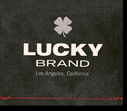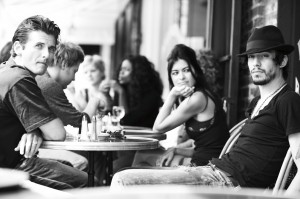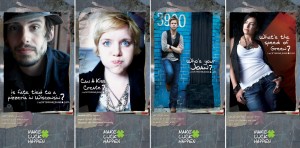we’re just like you — not
My critique of Lucky Jeans‘ “Lucky Few” campaign
. For those of you who didn’t see it, here goes:
For decades, fashion advertising seems to have followed a formula that goes something like this: Gorgeous models + famous photographer = stunning print campaign. Perhaps models were switched out for celebrities or a gimmick was thrown in the mix but, overall, there really hasn’t been much in the way of innovation in apparel brands’ marketing. For the most part, the people wearing those clothes have been stunning, and chances are they don’t look anything like you do.
That’s why the recently launched “Lucky Few” campaign from Lucky Brand seemed to have so much potential. As the press release explained, the fashion label had selected a group of “artisans”—ranging from musicians to an aspiring actress—to model its fall 2008 collection. The idea of choosing real-life creative types as models was intended to underscore the brand’s “message of individualism and the belief that being original and creative should be celebrated.”
Sounds great, huh? I imagined an inclusive, celebratory campaign featuring actual people whose compelling-but-flawed selves would inspire us to carve our own creative paths through life. I think that’s the kind of fresh approach that apparel brands need. But it looks like we’re not going to luck out with the undifferentiated and unfocused campaign that Lucky’s delivered. 
They certainly don’t look like you and me, either. Remember the Dove “Real Beauty” campaign from 2004? That campaign featured everyday women, warts and all
What’s so bad about that? Well, the stated goal is authenticity, and that’s been undermined by highly stylized images like these. Along the way, differentiation has been another casualty; these shots make Lucky look like all the other high-concept apparel brands littering the glossy mags.
Lucky also could have escaped the sea of sameness by communicating a distinctive POV, but the messaging is scrambled. The brand’s homepage claims the “Lucky Few” is an “amazing group of individuals who used their talent to make luck happen,” while its Facebook page says they’re “people that live for creative expression.” Is the campaign about luck? Creativity? Individuality? Dreams?
The campaign signage only muddles things further. 
Postings by the brand’s Facebook friends suggest that I’m not the only one, either. In answer to the invitation to submit their own “lucky stories,” people have posted everything from a recounting of how they met their girlfriend at a party to a promotion for their budding musical career. It’s an attempt to harness social media, but the lasso has clearly slipped. Lucky’s Facebook page is primarily comprised of images of the Lucky Few, and it looks as though the print campaign has just been peeled off and stuck there. It’s no wonder that three weeks after its launch, the page has garnered only 1,000 fans and wall posts by 30 people—many of whom are Lucky employees (Zara, which launched its page a month earlier, now has more than 160,000 fans and 500-plus wall posts).
At a time when brands have to take greater creative strides to get noticed, I wish that Lucky had done more than follow in the well-worn footprints. I guess that goes to show there’s a difference between wishing for something and making your own luck.